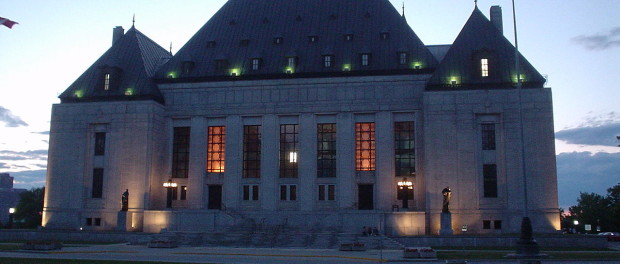The Federal Courts & Other Quebec Curios
 Look familiar? The Ottawa headquarters of the Federal Courts of Canada are actually headquartered in the Supreme Court Building. Photo credit: Stephen Boisvert/Flickr/Wikimedia Commons.
Look familiar? The Ottawa headquarters of the Federal Courts of Canada are actually headquartered in the Supreme Court Building. Photo credit: Stephen Boisvert/Flickr/Wikimedia Commons.
While not as fancy as Canada’s best known court, the Supreme Court, Canada has its own national court in the form of the Federal Court. As part of the right of the federal government in the Constitution Act of 1867 (The British North America Act) to create and maintain courts and other issues for peace, order, and the good government of the country, the federal government had a right to create such a court long ago. However, it may surprise that the Federal Court was only created relatively recently, in 1971.
The Federal Court’s precedent was the Exchequer Court of Canada, created around the same time as the Supreme Court. This court had a very limited jurisdiction, limited only to cases against the federal government that concerned revenue. The Supreme Court acted as an appeals to the Exchequer. Over time, the Exchequer gained more powers, including the ability to rule on breaches of the Combines Liability Act, whose goals would morph into the modern Competition Act. As the saying goes, the Exchequer Court of Canada never really did die, it faded into what is known as the Federal Court by the government passing a law called the Federal Courts Act. This Act created the Federal Court and transferred the powers of the Exchequer Court to the Federal Court and gave even more powers to the Federal Court. Further changes to the Federal Court occurred in 2003, with the Federal Court splitting into a Trial division (colloquially called the “Federal Court”) and an Appeal division (the “Federal Court of Appeal”). As per the Federal Courts Act, there are thirty-six regular judges and one Chief Justice for the Federal Court, and twelve regular judges and one Chief Justice for the Federal Court of Appeal. There are two official headquarters for the Federal Courts: one in Montreal, the other in Ottawa. Ottawa’s Federal Court is in the Supreme Court building.
The Federal Court has been in recent news since a group of students and their professor, Mr. Daniel Turp, launched a lawsuit related to the sale of light armoured vehicles to Saudi Arabia, an issue that is not only a Quebec curio, but a world issue. According to the Federal Courts Rules, the decree handling procedure in the Federal Courts, if the Federal government intends to respond, they have 10 days since the deposition of the lawsuit to submit their answer.
Visit Montreal’s federal court building at 30 rue McGill and the Ottawa federal court in the Supreme Court building at Parliament Hill. To read more about and support Mr. Turp and his students’ lawsuit, click here and here.





